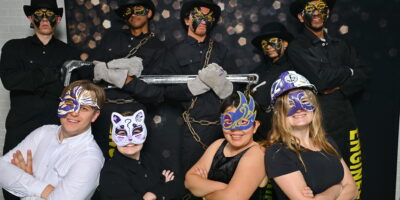Hey Everyone! I have no idea where the time goes, but apparently it’s that dreaded time of each term where exams are written, sleep is lost, and anxiety is high. Thankfully, exams are followed by the joy of holidays and the relaxation (hopefully) of work-terms. So hang in there! When things get tough, just visualize yourself as a lawnmower, demolishing any grass-exams that get in your way. I hope that made sense. My brain might just be turning into mashed potatoes.
Last weekend, 6 delegates from both A and B Societies, including myself, attended the National Conference on Women in Engineering, or NCWiE. This Canadian Federation of Engineering Students (CFES) conference is held once a year, and this year was hosted by the University of Saskatchewan. This was the last NCWiE, and next year will be renamed the Conference on Diversity in Engineering, or CDE, to encompass all aspects of diversity within the profession. Sessions at NCWiE took more of a general approach this year, as diversity in terms of gender identity, sexual preference, cultural and racial background, in addition to the role of women in engineering were all themes in various sessions throughout the conference. The sessions were run such that Saturday morning sessions were focused on communications, Saturday afternoon had sessions on identification, and Sunday morning was all about implementation. I felt that some of the sessions I attended were extremely valuable, and wanted my exec update for the week to bring a piece of NCWiE back to all of you reading this article to explain why diversity is more than just a buzzword. Here are little sub-articles (article-ception?) on two of my favourite sessions on communication, and visible and invisible minorities.
Effective Professional Communication- Corey Owen
Corey discussed the rhetorical model of communication where the message travels from the speaker to the audience, through the relation between the speaker and the audience. He described the three modes of appeal as a speaker.
1. Logos is the logical argument that supports the speaker’s claim. It is important as a speaker to choose arguments that the audience will find convincing.
2. Pathos focuses on the audience needs, values, and emotions. Choosing arguments that connects to the audience’s emotions and topics of interest to gain audience engagement.
3. Ethos is the self-reflection of the speaker. How does the speaker want to be perceived by the audience? Showing the audience an understanding of their needs and values and establishing credibility as a speaker to gain the audience’s attention.
Keeping these in mind as a speaker, reaching an audience and communicating your ideas will be more effective and natural.
Visible and Invisible Minorities- Jack Saddleback
Jack Saddleback is a minority in several ways. He is Aboriginal, transgendered, gay, and two-spirit, which is an umbrella term used by indigenous North Americans for gender variant individuals. He started the session by drawing a “Genderbread Man” and explaining different aspects one could use to describe their sexuality or gender.
1. Gender Identity is what is in your brain and whether you identify as a male, female, neither or both.
2. Gender Expression is how you dress and present yourself to the world.
3. Birth Sex is your biology, and whether you were born male, female, or intersex.
4. Romantic Orientation is who you are attracted to.
These four things do not necessarily affect one another. Society in general places a gender norm of a binary male-female system, which not everyone identifies with and it is hard for those who fall in between or outside of this binary. Jack was born a female and said even as a child he would feel conflicted with decisions as small as which public bathroom to go into, as he was physically a girl, but identified as a male. It was very interesting to hear about his experiences and attendees had a chance to think about things they normally wouldn’t think about. Jack also talked about the difference between equity and equality. Equality is giving everyone the same resources, however this does not result in the same opportunity. Equity is giving everyone equal opportunity to succeed.
If you have any questions about NCWiE or are interested to see my notes on these or other sessions, please do not hesitate to contact me. I have enjoyed being your VP External this term and I hope you all have had a wonderful term and that the rest of your time as a Waterloo Engineer, whether it’s 4 more months or 4 years and 4 months, is nothing short of amazing.




Leave a Reply